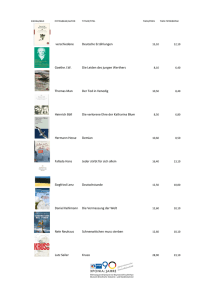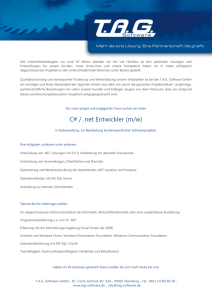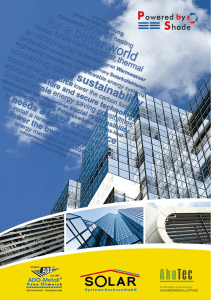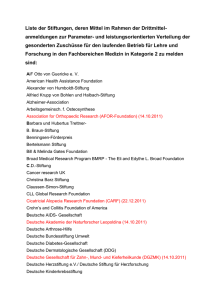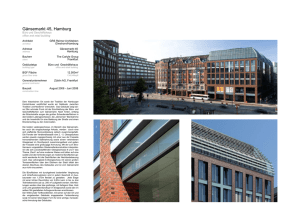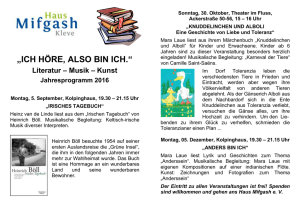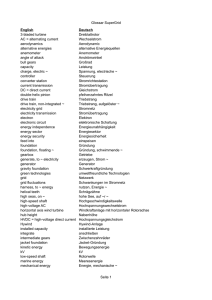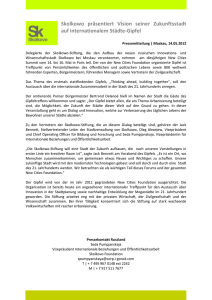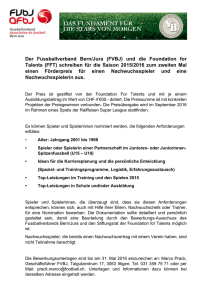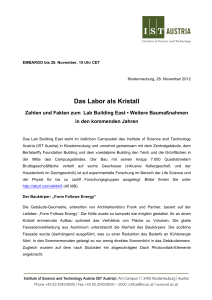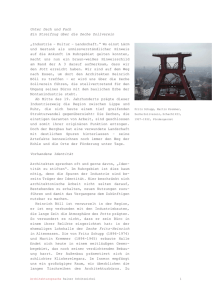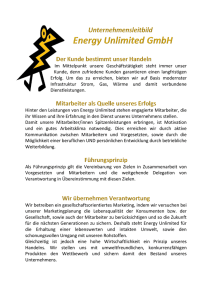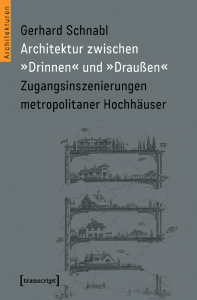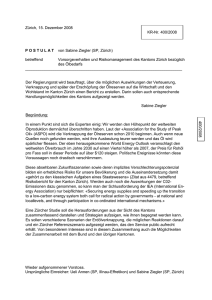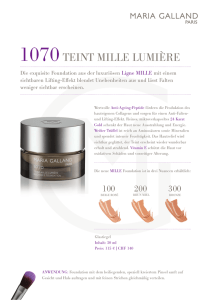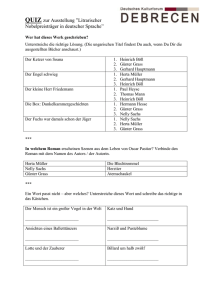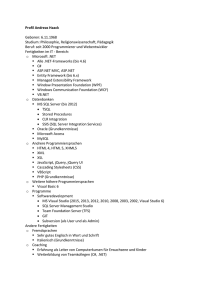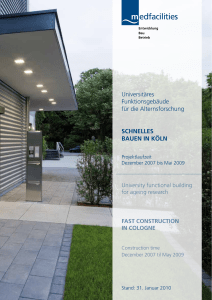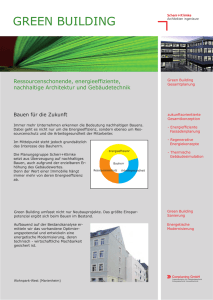Deutsch und Englisch - Heinrich-Böll
Werbung
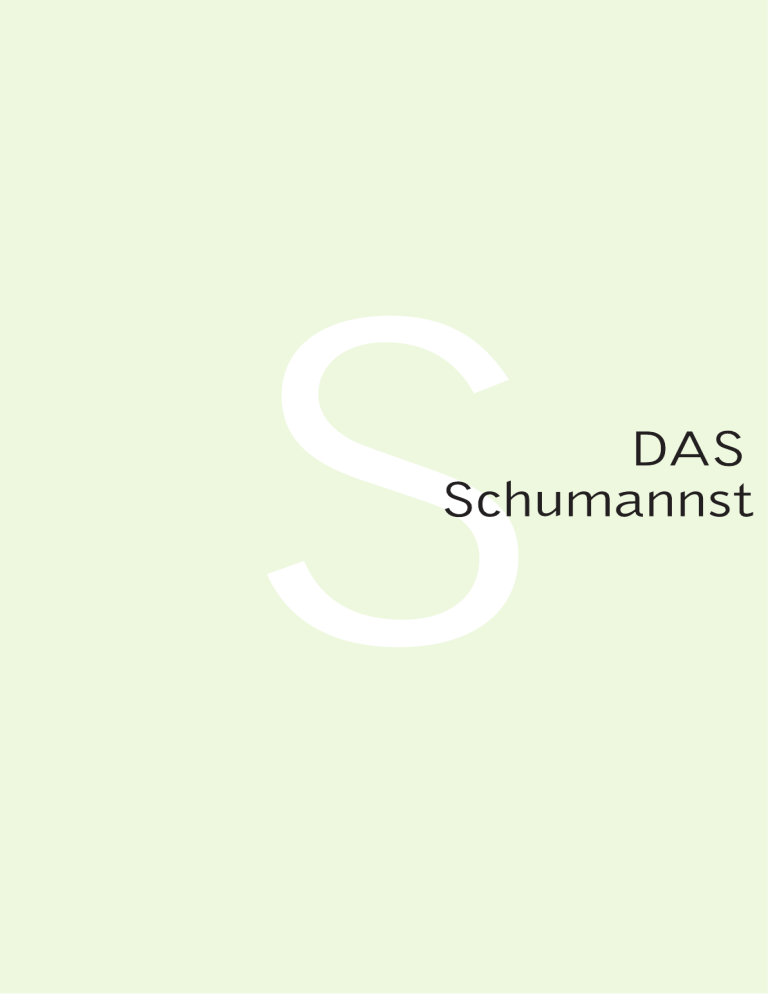
S C Vorwort dt. EIN OFFENES HAUS Unser neues Stiftungshaus in der Mitte Berlins spiegelt das Selbstverständnis und die Werte der Heinrich-Böll-Stiftung wider: Weltoffenheit, Transparenz, Ökologie und Nachhaltigkeit. In knapp drei Jahren Planungs- und Bauzeit ist ein modernes Büro- und Konferenzgebäude nach dem prämierten Entwurf des Architekturbüros e2a eckert und eckert aus Zürich entstanden. Das Gebäude setzt Maßstäbe für umweltgerechtes Bauen. So liegt der Energiebedarf des Hauses weit unter den Vorgaben der Energieeinsparverordnung. Darüber hinaus legt die Heinrich-Böll-Stiftung großen Wert auf ein gesundheitsförderndes Arbeitsumfeld. Auf einer Bruttogeschossfläche von rund 7000 Quadratmetern finden 185 Mitarbeiterinnen und Mitarbeiter moderne Büro- und Aufenthaltsflächen vor. Im variabel gestaltbaren Veranstaltungszent- Preface rum gibt es Platz für bis zu 300 Personen. Damit sind auch große und mehrtägige Konferenzen im eigenen Haus möglich sowie Vermietungen. Der Stiftungsbau wurde aus öffentlichen Mitteln finanziert. Daraus leitet sich für die Heinrich-BöllStiftung die Verpflichtung ab, der Gesellschaft einen möglichst großen Gegenwert zurückzugeben: Mit aktuellen Diskussionen, internationalen Konferenzen und einem vielseitigen Weiterbildungsangebot für politisch und kulturell Interessierte wollen wir Orientierung bieten und zum politischen Handeln ermutigen. Wir freuen uns auf Ihren Besuch! Ralf Fücks, Barbara Unmüßig, Birgit Laubach Vorstand und Geschäftsführung Heinrich-Böll-Stiftung H engl. AN OPEN HOUSE Our new foundation headquarters in the center of Berlin reflects the self-image and the values of the Heinrich Böll Foundation: global openness, transparency, ecology and sustainability. In just three years of planning and building time, a modern office and conference building has taken shape from the prize-winning design by the Zurich architecture firm of e2a eckert eckert. The building sets new benchmarks in environmentally compatible construction. Its energy consumption is far below the legal guidelines for energy conservation. The Heinrich Böll Foundation also puts great value on a healthy working environment. The total of approximately 7,000 square meters of building area features modern office space for the 185 employees. The conference center holds up to 300 people in varying configurations, making it possible to hold large multi-day conferences at the location as well. The construction of the Foundation headquarters was financed with public funds. This means that the Heinrich Böll Foundation has the obligation to give back as much as possible to society in equivalent value. We wish to offer direction to those interested in political and cultural issues and encourage political action through discussions on current events, international conferences and various programs offering further education. We look forward to your visit! Ralf Fücks, Barbara Unmüßig, Birgit Laubach Executive Board and Management Heinrich Böll Foundation U dt. INHALT Kapitel 1 S. 6 DEM CREDO HEINRICH BÖLLS VERPFLICHTET S. 7 KLASSISCHE MODERNE UND TRANSPARENZ S. 8 DIE BELETAGE – KONFERENZ- UND TAGUNGSZENTRUM S. 9 DAS ENERGIEKONZEPT S. 10 FAKTOR 10 – MIT GUTEM GEWISSEN KÜHLEN S. 11 IM WINTER HEIZEN DIE SERVER – EINE «AUSGEZEICHNETE» IDEE S. 12 DAS ATRIUM ALS LUNGE Kapitel 2 Kapitel 3 Kapitel 4 Kapitel 4.1 Kapitel 4.2 Kapitel 4.3 M Kapitel 4.4 S. 12 SCHLÜSSEL ZUM ERFOLG – INTEGRALE PLANUNG Kapitel 5 S. 14 CHRONOLOGIE Kapitel 6 S. 16 ZAHLEN UND FAKTEN Kapitel 7 S. 17 BILDREGISTER engl. CONTENT Chapter 1 P. 6 COMMITED TO HEINRICH BÖLL’S CREDO Chapter 2 P. 7 MODERNISM AND TRANSPARENCY Chapter 3 P. 8 THE BELETAGE – A CONFERENCE CENTRE Chapter 4 P. 9 THE ENERGY PLAN Chapter 4.1 P. 10 FACTOR OF 10 – COOLING WITH A CLEAN CONSCIENCE Chapter 4.2 P. 11 WINTER HEATING FROM THE SERVERS – AN AWARD-WINNING IDEA P. 12 THE ATRIUM AS A LUNG P. 12 THE KEY TO SUCCESS: INTEGRATED DESIGN P. 14 CHRONOLOGY P. 16 FACTS AND FIGURES P. 17 INDEX OF PICTURES Chapter 4.3 Chapter 4.4 Chapter 5 Chapter 6 Chapter 7 1 dt. DEM CREDO HEINRICH BÖLLS VERPFLICHTET Das Deutsche Theater direkt gegenüber, die Bundesgeschäftsstelle von Bündnis 90/ Die Grünen, das Bundespressehaus und das Regierungsviertel in Fuß- und Fahrradnähe – günstiger könnte der neue Standort der grün-nahen Heinrich-Böll-Stiftung mitten in Berlin nicht sein. Die Schumannstraße 8 verbindet auf ideale Weise Politik, Ökologie, Kunst, Kultur und moderne Architektur. Demokratie und Menschenrechte durchsetzen, gegen die Zerstörung unseres globalen Ökosystems angehen, soziale Teilhabe für alle gewährleisten, Konflikte mit zivilen Mitteln lösen, die Freiheit des Individuums gegen staatliche und wirtschaftliche Übermacht verteidigen – das sind die Ziele, die das Handeln der Heinrich-Böll-Stiftung bestimmen. 1 engl. In diesem Sinne ist die Stiftung auch ihrem Namensgeber verpflichtet, dem Schriftsteller und Literaturnobelpreisträger Heinrich Böll (1917 – 1985). Mit ihm verbinden viele Menschen nicht nur sein herausragendes literarisches Schaffen, sondern auch sein gesellschaftliches Engagement. Heinrich Bölls Credo «Einmischung ist die einzige Möglichkeit, realistisch zu bleiben» bestimmt die tägliche Arbeit der Heinrich-Böll-Stiftung im Inund Ausland. Die Stiftung kooperiert mit 16 Landesstiftungen in allen Bundesländern und unterhält Büros in 28 Ländern auf vier Kontinenten. A COMMITED TO HEINRICH BÖLL’S CREDO Directly across the street from the Deutsche Theater, biking and walking distance from the national party headquarters of Alliance90/ The Greens, the German Federal Press Office and the government district, the Heinrich Böll Foundation's new location in the center of Berlin could not be more convenient. The Schumannstrasse 8 address for the Green-affiliated Foundation combines politics, ecology, art, culture and modern architecture in an ideal way. The Heinrich Böll Foundation aims in its actions to advocate for democracy and human rights, oppose the destruction of our global ecosystem, guarantee social participation for all, resolve conflicts through civil means, and defend the freedom of the individual from superior state and economic forces. The Foundation is also committed to its namesake in this sense, the writer and Nobel laureate Heinrich Böll (1917-1985). Many people connect not only to Böll's outstanding literary work, but also and above all to his social involvement. Heinrich Böll's credo, "Meddling is the only way to stay relevant", informs the daily work of the Heinrich Böll Foundation both within Germany and internationally. The Foundation cooperates with 16 regional foundation offices in all of the German states and maintains offices in 28 countries on four continents. P S 6 2 dt. KLASSISCHE MODERNE UND TRANSPARENZ Der Neubau der Heinrich-Böll-Stiftung verbindet die klassische Moderne von Mies van der Rohe mit der universalen Transparenz des Farnworth Houses von Frank Lloyd Wright. Diese Kombination reflektiert nicht nur die Philosophie der Heinrich-BöllStiftung in einzigartiger Weise, sondern gestattet Multifunktionalität in vielerlei Hinsicht: Das Tagungs- und Konferenzzentrum kann in unterschiedlich große Räume geteilt werden, der umgebende Stadtgarten spiegelt sich in den grünen Fenstern der Beletage. Das markante Gebäude fügt sich harmonisch in das historische Stadtbild ein. Ein rundum verglastes Foyer, geeignet für Empfänge und Ausstellungen, umschließt die große Haupttreppe, die zum angenehm hellen Konferenzbereich in der Beletage führt. Die Treppe ist mit einem Teppich ausgekleidet, der vom Berliner Künstler Via Lewandowsky gestaltet wurde. Er zeigt die Luftaufnahme einer Schafherde mit weißen und schwarzen Tieren. Die Herde steht als Metapher für die Verantwor- 2 engl. tung Einzelner in der Gruppe. Veränderung und Impulse gehen oft gerade von jenen aus, die der Herde ein Bewusstsein für andere Richtungen vermitteln. Inspiriert wurde der Künstler durch die Erzählung «Die schwarzen Schafe» von Heinrich Böll. Funktional, aber stilvoll präsentiert sich über der Beletage der Bürobereich mit einem Wechsel aus offenen und geschlossenen Räumen. Die Obergeschosse sind um einen offenen Innenhof angelegt. Wände aus Sichtbeton und unter der Decke verlaufende Leitungen verleihen dem gesamten Haus einen Werkstattcharakter. Auch der ökologische Anspruch der HeinrichBöll-Stiftung wurde beim Bau berücksichtigt. So ist das Haus nicht nur mit einer wirkungsvollen Wärmedämmung ausgerüstet, darüber hinaus wird es im Sommer durch eine Verdunstungsanlage im Keller gekühlt. Im Winter wird die Abwärme der Server zum Heizen genutzt. N MODERNISM AND TRANSPARENCY The new Heinrich Böll Foundation building combines the modernism of Mies van der Rohe with the universal transparency of Frank Lloyd Wright's Farnworth House. This combination is not only a unique reflection of the Heinrich Böll Foundation's philosophy, it also allows for multifunctionality in many respects: the conference and meeting center can be divided into spaces of different sizes; the surrounding city park is reflected in the green windows of the bel étage. The striking building integrates beautifully with the historical cityscape. A foyer with wraparound windows, suitable for receptions and exhibits, surrounds the large main staircase, which leads to a bright, comfortable conference area on the bel étage. The stairs are carpeted in a design created by Berlin artist Via Lewandowsky, who has depicted an aerial shot of a herd of white and black sheep. The herd is a metaphor for the responsibility of the individual within the group: stimulus and change often come from precisely those who make the herd aware of new approaches. The artist was inspired by Heinrich Böll's story, «The Black Sheep». Above the bel étage is the functional yet stylish office area, with alternating open and enclosed spaces. The upper floors are positioned around an open interior courtyard. Exposed concrete walls and ductwork running under the ceiling give the whole building a workshop feel. The Heinrich Böll Foundation's environmental standards were also taken into account during construction. This means that the building not only has efficient thermal insulation, it also stays cool in summer through an evaporative cooling installation in the basement. In winter, the warmth produced by the computer network servers is used for heating. P S 7 3 dt. DIE BELETAGE – KONFERENZUND TAGUNGSZENTRUM Die Beletage wird als Konferenz- und Tagungszentrum für nationale und internationale Veranstaltungen genutzt. Auch hier zeigt sich der Anspruch der Heinrich-Böll-Stiftung auf Transparenz und Variabilität: Die Beletage ist rundum verglast, vielseitig nutzbar, unterschiedlich möbliert und mit modernster Technik ausgestattet. Der Große Saal bietet Platz für 300, der Kleine Saal für 90 Personen. Beide Säle sind teilbar. Darüber hinaus gibt es einen exklusiven Konferenzraum für 22 Personen sowie großzügige Foyerflächen und eine Bibliothek. Im Erdgeschoss befindet sich eine nicht öffentliche Cafeteria und die dazugehörige, erstklassig 3 engl. ausgestattete Küche, die ebenfalls für Veranstaltungen genutzt werden können. Auch die Technik lässt keine Wünsche offen: W-Lan ist ebenso verfügbar wie modernste Audiound Videotechnik. Schwenkbare Beamer ermöglichen es, die Säle sowohl quer als auch längs zu bespielen. Im Großen Saal sind Doppelprojektionen möglich. Ton und Bild können je nach Bedarf in alle Räume – einschließlich Foyer und Cafeteria – übertragen werden. Für Gehörbehinderte ist außerdem eine Induktionsschleife installiert. Das Konferenz- und Tagungszentrum kann angemietet werden, bitte lesen Sie dazu auch die Mietinformationen. N THE BELETAGE – A CONFERENCE CENTRE The bel étage is used as a conference and meeting center for national and international events. Here, too, the Heinrich Böll Foundation's standards of transparency and versatility are apparent: The bel étage has wraparound windows, can be configured in multiple ways, has a variety of furniture options and is furnished with the latest technology. The large hall has space for 300 people; the smaller hall holds 90. Both halls can be divided. What's more, there is an exclusive conference room that holds 22 people, as well as a generous foyer area and a library. The ground floor holds a cafeteria that is not open to the public and an attached kitchen with first-class equipment that can also be used to cater events. The technical equipment also fulfills every need: The most modern audio/video technology is available, as well as Wi-Fi. Swivel-mounted projectors make it possible to use the hall lengthwise or widthwise. Double projections are possible in the large hall. Sound and video can be broadcast throughout the space as needed, including the foyer and cafeteria. There is also an induction loop for the hard of hearing. The conference and meeting center is available for rental; please consult the rental information for more details. P S 8 4 dt. DAS ENERGIEKONZEPT Das neue Stiftungshaus gehört energetisch zur ökologischen Avantgarde: Wenig, aber hoch-innovative Technik sorgt in dem modernen Bürogebäude für ein angenehmes Raumklima. Der Energieverbrauch in Höhe von 55.7 kWh ⁄ m² unterbietet die gesetzlich vorgeschriebenen Werte der Energieeinsparverordnung um die Hälfte. Damit nimmt das Gebäude eine Vorreiterrolle im modernen Büro- und Konferenzgebäudebau ein. Dank der engen Zusammenarbeit zwischen Bauherrschaft, Architekten und Gebäudetechnik-Ingenieuren konnten die innovativen Lösungen innerhalb eines eng abgesteckten finanziellen Rahmens realisiert werden. Nachhaltigkeit ist einer der Grundwerte der Heinrich-Böll-Stiftung. Nachhaltigkeit war daher auch das Leitprinzip für das Energiekonzept, das 4 engl. vom Schweizer Ingenieurunternehmen Basler & Hofmann für die Stiftung entwickelt wurde. Es folgt drei wesentlichen Regeln: — Intelligente Systeme mit möglichst wenig Geräten – das spart Ressourcen und hält die Installations- und Betriebskosten gering. — Energie ist erst verloren, wenn sie das Gebäude verlässt. Abwärme wird vorher auf innovative Weise wieder genutzt. — Möglichst natürliche und nutzerbestimmte Lüftung und Kühlung. In Partnerschaft mit der Firma Grammer Solar wurde auf dem Dach eine Photovoltaik-Anlage installiert, die einen Primärenergiebeitrag von etwa 53000 kWh jährlich erbringt und dem Stromnetz zugeführt wird. S THE ENERGY PLAN The energy concept for new head office of the Heinrich Böll Foundation in Berlin puts the building in the ecological vanguard. Highly innovative technology in small doses creates a pleasant working environment in the modern office spaces. It boasts an energy consumption of only 55.7 kWh/m², which undercuts the legal maximum by half. This makes the building a leader in the field of modern office and conference centre design. Close cooperation between the client, the architect and the building services engineers ensured that innovative solutions were successfully implemented within a tight budget. Sustainability is one of the core values of the Heinrich Böll Foundation. Sustainability was also the guiding principle of the energy concept, which was developed for the foundation by the Swiss engineering firm Basler & Hofmann, from Zurich. The concept follows three basic principles: — Intelligent systems with as little equipment as possible. This saves resources and keeps down the installation and operating costs. — Energy is not lost until it leaves the building. Waste heat is recycled in an innovative manner. — Ventilation and cooling are as natural as possible and give users maximum control. In partnership with Grammer Solar, a photovoltaic system has been installed on the roof. This has an annual energy yield of some 53,000 kWh and feeds into the power supply system. P S 9 4.1 dt. DAS ENERGIEKONZEPT FAKTOR 10 – MIT GUTEM GEWISSEN KÜHLEN Moderne Bürogebäude unterliegen einem Paradox: Sind sie gut wärmegedämmt, benötigen sie zwar wenig Heizenergie, dafür steigt jedoch der Kühlenergiebedarf. Denn die zahlreichen Bürogeräte heizen das Gebäude von innen auf und die überschüssige Wärme kann nicht mehr durch eine «undichte» Gebäudehülle entweichen. In vielen herkömmlichen Bürogebäuden läuft deshalb im Sommer die Klimaanlage mit hohem Energieverbrauch. Für die Beschäftigten bedeutet dies: Fenster geschlossen halten. Nicht so bei der Heinrich-Böll-Stiftung: Hier wird nicht mit der Kältemaschine, sondern mit Wasser gekühlt. In allen Büros befinden sich entlang der Fensterfronten sogenannte Brüstungsgeräte. In ihnen befindet sich ein Hochleistungswärmetauscher, durch den im Sommer Wasser mit einer Temperatur von 20° C zirkuliert. Ein kleiner Ventilator im Brüstungsgerät sorgt dafür, dass sich 4.1 engl. die gekühlte Luft im Raum verteilt. Auch bei Außentemperaturen von 30° C steigt die Raumtemperatur nicht über einen Maximalwert von 25° C. Das dafür benötigte Kühlwasser wird über einen sogenannten adiabatischen Rückkühler im Keller des Gebäudes erzeugt: Auf seinen Rohren wird Stadtwasser versprüht. Dabei entsteht Verdunstungskälte, die die Kühlwassertemperatur wieder auf 20° C reduziert. So gekühlt gelangt das Wasser zurück in den Kreislauf. Die Vorteile des Systems liegen auf der Hand: Konventionelle Klimasysteme benötigen Wasser mit einer Temperatur von 8 – 10° C. Das Kühlwasser wird im Raum dann wieder auf 12 – 18° C erwärmt. Das verschlingt unnötig viel Energie. Beim System, das in der Heinrich-Böll-Stiftung eingesetzt wird, ist kein «Temperatursprung» nötig. Dadurch wird hier um den Faktor 10 effizienter gekühlt als mit herkömmlichen Systemen. T THE ENERGY PLAN FACTOR OF 10 – COOLING WITH A CLEAN CONSCIENCE Modern office buildings suffer from an inherent paradox: they are well insulated and therefore need less energy for heating, but instead they need more for cooling. The huge quantity of office equip-ment in use these days warms the building up from the inside and there are no longer any poorly insulated points in the envelope through which excess heat can escape. In many conventional office buildings, the air conditioning has to run at full capacity throughout the summer, guzzling energy. For the occupants, that means having to keep the windows closed. Not so at the Heinrich Böll Foundation: here it is water that is used for cooling, not machinery. Outlet slits run at cill level along the glazing in every office. The cill casing houses high-performance heat-exchangers, through which water at a temperature of 20° C circulates in summer. A small ventilator inside ensures that that cooled air is distributed throughout the room. Even when the temperature outside is over 30° C, the room temperature does not rise above 25° C. The water for cooling comes from what is known as an adiabatic recooler, situated in the basement. This has cooling fins, onto which normal tap water is sprayed. The energy used when this evaporates is drawn out of the fins, reducing the temperature of the coolant water inside to 20° C. The cooled water is then ready to circulate through the undercill heat exchangers once more. The advantages of such a system are plain to see: conventional air-conditioning systems need water at a temperature of 8-10° C. That coolant is warmed up again in the rooms to a temperature of 12° to 18° C, which consumes an unnecessarily large quantity of energy. The system that is used in the Heinrich Böll Foundation does not need any such «jump in temperature». As a result, it cools ten times more efficiently than a conventional system would. P S 10 4.2 dt. DAS ENERGIEKONZEPT IM WINTER HEIZEN DIE SERVER – EINE «AUSGEZEICHNETE» IDEE Das Brüstungsgerät sorgt im Sommer für Kühlung, im Winter für Wärme. Und auch beim Heizen ist es außergewöhnlich effizient. Während herkömmliche Heizsysteme eine Heizwassertemperatur bis 50° C benötigen, wärmt das innovative Brüstungsgerät die Büros bereits mit einer Vorlauftemperatur von 28° C. Und was andernorts lästige Wärmelast ist, wird hier effektiv genutzt: die Abwärme der Server. Die Server der Heinrich-Böll-Stiftung befinden sich in sogenannten Cool-Racks – ein «Kühl-Schrank» im wahrsten Sinne des Wortes. Damit können die Server in die Gebäudetechnik eingebunden und ihre Abwärme direkt nutzbar gemacht werden. Die Cool-Racks werden von Wasser mit einer Tempera- 4.2 engl. tur von 23° C durchflossen. Die Server erwärmen das Wasser auf eine Temperatur von ca. 30° C. Das so erwärmte Wasser wird dann in das Heizsystem eingespeist und sorgt in den Büros für angenehme Temperaturen im Winter. Die Wärme «kostet» also lediglich die Pumpenergie, die für die Umwälzung des Wassers benötigt wird – 90 Prozent kann direkt als Heizenergie genutzt werden. Im Sommer werden auch die Server über den adiabatischen Rückkühler gekühlt. Für dieses außergewöhnliche Konzept der Planer von Basler & Hofmann erhielt die Heinrich-Böll-Stiftung den Green-CIO-Award. Der Preis würdigt innovative Projekte, die die Energieeffizienz von IT-Systemen deutlich verbessern. R THE ENERGY PLAN WINTER HEATING FROM THE SERVERS – AN AWARD-WINNING IDEA The under-cill installation that cools the offices in summer also heats them in winter – and it does so with the same high efficiency. Whereas conventional heating systems need hot water at temperatures of up to 50° C, the innovative under-cill installation functions with a flow temperature of 28° C. It also makes effective use of heat that elsewhere is just a nuisance to be disposed of: the heat produced by the computer network servers. The servers of the Heinrich Böll Foundation are kept in cool racks, which remove heat rather as a fridge does. This arrangement integrates the servers with the building services system and makes their heat directly available to it. Water flows into the cool racks at a temperature of 23° C, where it is warmed by the servers to around 27° C. It is then fed into the heating system and circulated through the offices to keep them comfortably warm in winter. The only «cost» of this heat is the energy needed by the pumps to circulate the water – ninety percent can be used directly as heat energy. In summer, the servers too are cooled by the adiabatic recooler. For this extraordinary concept, devised by Basler & Hofmann, the Heinrich Böll Foundation has received the Green CIO Award. This award is given in recognition of innovative projects that significantly improve the energy efficiency of IT systems. P S 11 4.3 dt. DAS ENERGIEKONZEPT DAS ATRIUM ALS LUNGE Damit der CO2-Gehalt in der Raumluft auf einem normalen Niveau bleibt, ist eine regelmäßige Frischluftzufuhr nötig. Viele moderne Bürogebäude funktionieren nur mit aufwändigen Lüftungssystemen. Bei der Heinrich-Böll-Stiftung setzt man dagegen auf eine natürliche Lüftung: Das Atrium im Innern des Gebäudes wirkt wie eine Lunge. Im Sommer wird der Innenhof durch das offene Atriumsdach natürlich belüftet (siehe Graphik 1). Im Winter, wenn das Dach geschlossen ist, sorgt ein Lüftungsgerät mit Wärmerückgewinnung für die 4.3 engl. Frischluftzufuhr in das Atrium. Dabei dient die Abwärme der Abluft zum Aufwärmen der Frischluft. Die Büros lassen sich mit hohen Fensterflügeln zum Atrium und zu den Fluren im Innern des Gebäudes hin öffnen. Diese Querlüftung versorgt die Innenräume ganz nach Bedarf mit frischer Luft – dank des Atriums ohne die sonst üblichen Wärmeverluste im Winter. Durch die Ausnutzung der natürlichen Thermik im Atrium kann mit minimalem Energieeinsatz ein Maximum an Wohlbefinden im Gebäude erzielt werden. THE ENERGY PLAN THE ATRIUM AS A LUNG A In order to keep the CO2 content of the air inside the building down to a normal level, a regular inflow of fresh air is necessary. Many modern office buildings function only with costly ventilation systems. The Heinrich Böll Foundation, in contrast, has opted for a solution using natural ventilation. The atrium within the building works rather like a lung. In summer, the internal courtyard is aired naturally through the open roof of the atrium. In winter, when the roof is closed, a ventilation system coupled with heat exchangers maintains a flow of 4.4 dt. fresh air into the atrium. This extracts heat from the ex-haust air and uses it to warm the fresh air being brought in. The office spaces and internal corridors can be opened up to the atrium, creating a cross current to provide the interiors with fresh air as needed. Thanks to the atrium, this occurs without the heat loss that would otherwise be experienced in winter. By exploiting the natural convection currents in the atrium, it is possible to achieve a maxi-mum of comfort in the building with a minimum of energy consumption. DAS ENERGIEKONZEPT SCHLÜSSEL ZUM ERFOLG: INTEGRALE PLANUNG Ein modernes Bürogebäude ist ein komplexes System. Nur wenn Architektur, Fassade und Gebäudetechnik fein aufeinander abgestimmt sind, kann der Primärenergieverbrauch auf ein Minimum reduziert werden. In der Energiebilanz des neuen Büro- 4.4 engl. gebäudes wurde nicht nur der laufende Energieverbrauch im Betrieb berücksichtigt, sondern auch die Energie, die nötig ist, um die Geräte und Anlagen zu produzieren (siehe auch Graphik 2). THE ENERGY PLAN THE KEY TO SUCCESS: INTEGRATED DESIGN A modern office building is a complex system. Only when the architecture, the façade and the building services are closely coordinated can primary energy consumption be reduced to a minimum. The energy balance of the new office building takes into account not only the energy consumed in daily operation, but also the energy needed to produce the technical systems and equipment (see graphic 2). P S 12 Graphik 1 Graphic 1 DAS ATRIUM THE ATRIUM Im Sommer geöffnet Open in the summer Graphik 2 Im Winter geschlossen Closed in the winter S Graphic 2 DER PRIMÄRENERGIEVERBRAUCH THE PRIMARY ENERGY CONSUMPTION 130 kWh/m² Konventionelle neue Bürogebäude Conventional office building 55,7 kWh/m² Gebäude der Heinrich-Böll-Stiftung Office building of the Heinrich Böll Foundation P S 13 5 CHRONOLOGIE CHRONOLOGY space.» The Zurich firm Basler & Hofmann receives the contract for the building services engineering. DEZEMBER 2006 Die Hermann Kirchner Projektgesellschaft wird Generalübernehmer. Das Haus wird von ihr gebaut und für den Zeitraum von 15 Jahren bewirtschaftet. Der Public-Private-Partnership-Vertrag wird unterzeichnet. JULI 2005 DECEMBER 2006 Nach mehrjähriger Suche entscheidet sich die Heinrich-Böll-Stiftung, das Grundstück in der Schumannstraße 8 zu bebauen. Daraufhin wird ein internationaler Architektenwettbewerb ausgerufen, an dem sich 200 Architekturbüros beteiligen. Per Losverfahren werden 25 Architekten eingeladen, einen Realisierungsvorschlag zu erarbeiten. JULY 2005 Hermann Kirchner Projektgesellschaft becomes the general contractor. They will handle the construction and manage the building for a period of 15 years. The public-private partnership contract is signed. S After several years of searching, the Heinrich Böll Foundation decides to develop the parcel at Schumannstraße 8. They convoke an international architectural competition for this purpose, in which 200 architecture firms participate. A lottery is held, and 25 architects are invited to develop an implementation proposal. APRIL 2007 Die Bauarbeiten des sechsgeschossigen Niedrigenergiegebäudes (inklusive Unter geschoss) beginnen. APRIL 2007 Construction work begins on the six-story (including the basement) low-energy building. MÄRZ 2006 Die prominent besetzte Jury unter Vorsitz von Frau Prof. Dipl.-Ing. Inken Baller entscheidet sich für den Entwurf des Schweizer Architektenduos Piet und Wim Eckert des Zürcher Büros E2A eckert eckert architekten. «Der Entwurf fasziniert durch die Idee eines schlanken Kubus, in den quasi über der Parkebene schwebend die öffentliche Hauptebene als Beletage eingearbeitet ist. Die Gebäudearchitektur ist klar strukturiert. Beeindruckend ist die exponierte Position des Konferenzbereichs und seine Sichtbarkeit im Stadtraum», so die Begründung der Jury. Den Zuschlag für die Gebäudetechnik erhält das Zürcher Büro Basler & Hofmann. JUNI 2007 Als Sieger des Wettbewerbs «Kunst am Bau» geht der Berliner Künstler Via Lewandowsky hervor. Aus der Begründung der Jury: «Das Kunst werk korrespondiert mit dem Gebäude und verwandelt die Treppe in einen Ort mit eigener ästhetischer und kommunikativer Qualität. […] Das Motiv bricht sich ironisch mit dem Zweck einer politischen Stiftung, deren Aufgabe es ist, politische Bildung zu betreiben und damit meinungsbildend zu wirken.» MARCH 2006 JULY 2007 The panel of high-profile judges, chaired by Prof. Dipl.-Eng. Inken Baller, selects the design by Swiss architects Piet and Wim Eckert, from the Zurich firm of e2a eckert eckert architekten. Their rationale: «The design is fascinating because of its idea of a slender cube where the main level is incorporated as a bel étage that appears to float over the parking level. The architecture of the building is clearly structured. The exposed position of the conference area is impressive, as is its visibility in the public Berlin artist Via Lewandowsky wins the «Kunst am Bau» competition for architectural art. From the jury's rationale: «The work of art corresponds to the building and transforms the staircase into a place with its own aesthetic and communicative quality. […] The subject of the picture breaks ironically with the purpose of a political foundation, whose task is to tackle political education and to affect the formation of opinion.» P S 14 5 CHRONOLOGIE CHRONOLOGY JULI 2007 SEPTEMBER 2008 Der Grundstein wird gelegt. Die beiden Stiftungsvorstände geben dem Bau ihre Wünsche mit ins Fundament, ebenso der Architekt Piet Eckert. Musikalisch wird die Grundsteinlegung von dem Cellisten Frank Wolff begleitet, der seine HeinrichBöll-Sonate (Variation auf h – b – s) vorträgt. JULY 2007 Festliche Einweihung der Stiftungszentrale durch Bundespräsident Horst Köhler. Rund 700 Gäste und Mitarbeiterinnen und Mitarbeiter der Stiftung nehmen an der Eröffnung teil. Grußworte sprechen neben dem Bundespräsidenten auch Reinhard Bütikofer, Parteivorsitzender Bündnis 90 / Die Grünen, René Böll für die Erbengemeinschaft Heinrich Böll und Piet Eckert vom Architektenbüro e2a in Zürich. E The cornerstone for the building is laid. Both members of the Executive Board place their wishes for the building's future into the foundation, as does the architect Piet Eckert. Cellist Frank Wolff performs the musical accompaniment for the laying of the cornerstone with his Heinrich Böll Sonata (Variation on an Initial Theme). MÄRZ 2008 SEPTEMBER 2008 Formal dedication of the foundation headquarters by German President Horst Köhler. Some 700 guests and foundation employees take part in the opening celebration. In addition to the words from Köhler, there are also speeches from Reinhard Bütikofer, party chairman for Alliance90/ The Greens, René Böll on behalf of Heinrich Böll's heirs, and Piet Eckert, the Swiss architect from the Zurich firm of e2a. Die Heinrich-Böll-Stiftung feiert Richtfest. MARCH 2008 The topping-off ceremony is held. JUNI 2008 Der Green-CIO-Award wird an die Heinrich-BöllStiftung verliehen. Die Heiz-, Klima- und Rechenzentrums-Technik ist so ausgelegt, dass die Wärme aus dem Rechnerraum das Gebäude heizt, so dass kaum zusätzliche Heizmaßnahmen nötig sind. JUNE 2008 The Heinrich Böll Foundation is awarded the Green CIO Award. The technology used for the building's computer network server room, heating and climate control is set up such that the warmth from the server room is used to heat the building, so that almost no additional heating is necessary. JUNI 2008 Die Heinrich-Böll-Stiftung bezieht ihr neues Domizil: einen klassischen Kubus mit einer schwebenden, rundum verglasten Beletage. JUNE 2008 The Heinrich Böll Foundation moves into its new home: a classical cube with a floating bel étage featuring wraparound windows. P S 15 6 ZAHLEN UND FAKTEN dt. GRÖSSE Baufeld Bebaute Fläche Umbauter Raum Gesamtgeschossfläche Gesamtnutzfläche Hauptnutzfläche des Konferenz- und Tagungsbereichs ENERGIEKONZEPT, BAUPHYSIK, ÖKOLOGIE, TGA-PLANUNG 2 106 m² 1 263 m² 26 992 m³ 3 971 m² (NF) 6 968 m² (BGF) 1 357 m² Basler & Hofmann Ingenieure und Planer AG Philipp Grob Forchstraße 395 CH-8032 Zürich T 00 41 – 79 35 38 982 I www.bhz.ch PHOTOVOLTAIKANLAGE (Räume ohne Flure und Servicebereiche) Grammer Solar Oskar-von-Miller-Straße 8 92224 Amberg T 0 96 21 – 30 85 712 E [email protected] ENERGIEPARTNERSCHAF T In Energiepartnerschaft mit der Firma Grammer Solar wurde eine Photovoltaikanlage auf dem Dach des neuen Gebäudes installiert. KOSTEN GENERALÜBERNEHMER 8 Hermann Kirchner Projektgesellschaft mbH Dr.-Ing. Jürgen Siegel Hermann-Kirchner-Straße 6 36251 Bad Hersfeld T 0 66 21 – 16 23 41 E [email protected] Baukosten 14,0 Millionen Euro brutto (einschl. Kosten für Grundstückserwerb) ARCHITEKTEN eckert eckert architekten / e2a Hartumstraße 76 CH-8005 Zürich T 00 41 43 – 44 44 010 E [email protected] I www.e2a.ch 6 engl. SIZE Buiding site Coverage Surrounded space Floor space Gross floor area Floor area of the conference and meeting centre (Rooms without corridors and service areas) PARTNERSHIP FACTS AND FIGURES ENERGY PLAN, BUILDING PHYSICS, ECOLOGY ETC. 2 106 m² 1 263 m² 26 992 m³ 3 971 m² (NF) 6 968 m² (BGF) 1 357 m² Basler & Hofmann Ingenieure und Planer AG Philipp Grob Forchstraße 395 CH-8032 Zürich P 00 41 – 79 35 38 982 I www.bhz.ch PHOTOVOLTAIC SYSTEM Grammer Solar Oskar-von-Miller-Straße 8 92224 Amberg P 00 49 96 21– 30 85 712 E [email protected] In partnership with Grammer Solar, a photovoltaic system has been installed on the roof. COSTS GENERAL CONTRACTOR 14 million Euro (incl. costs for purchase of land) Hermann Kirchner Projektgesellschaft mbH Dr.-Ing. Jürgen Siegel Hermann-Kirchner-Straße 6 36251 Bad Hersfeld P 00 49 66 21 – 16 23 41 E [email protected] ARCHITECTS eckert eckert architekten / e2a Hartumstraße 76 CH-8005 Zürich P 00 41 43 – 44 44 010 E [email protected] I www.e2a.ch P S 16 Weitere Informationen über das Gebäude und die Konditionen zur Anmietung der Beletage unter: www.boell.de Herausgegeben von der Heinrich-Böll-Stiftung Edited by the Heinrich Böll Foundation 1. Auflage First edition, Berlin 2009 © Heinrich-Böll-Stiftung Alle Rechte vorbehalten All rights reserved Fotos Photos: Jan Bitter (Pic. Nº 01 – 22); Manuela Schneider; Andreas Böhmig Gestaltung Layout: blotto design, Berlin Druck Printing: agit-druck, Berlin Heinrich-Böll-Stiftung Schumannstr. 8, 10117 Berlin, T 0 30 – 28 53 40 F 0 30 – 28 53 41 09 [email protected] www.boell.de ISBN 978-3-927760-97-4 For more information on the building and booking terms for the Beletage, please see: www.boell.de
